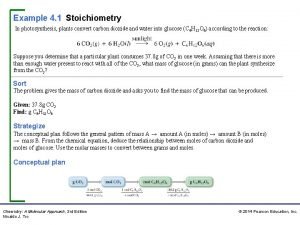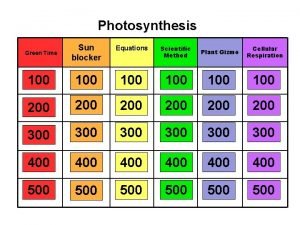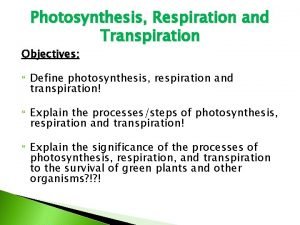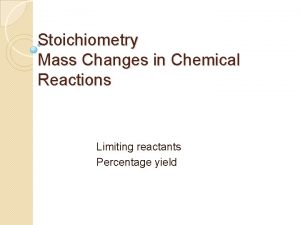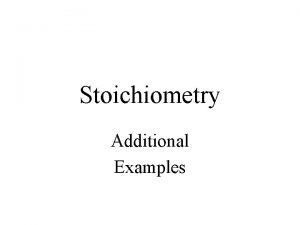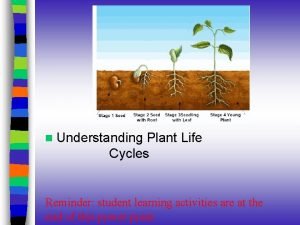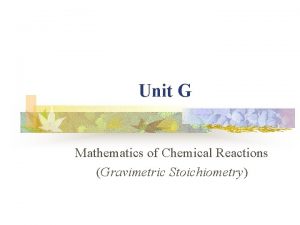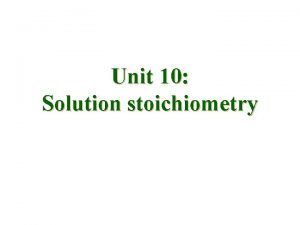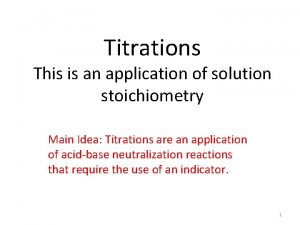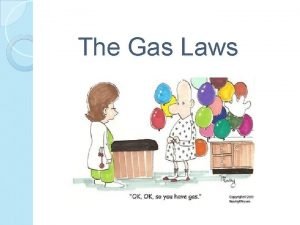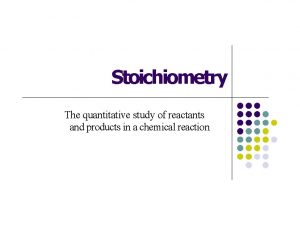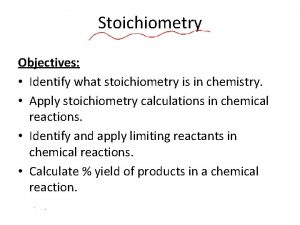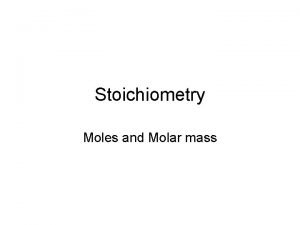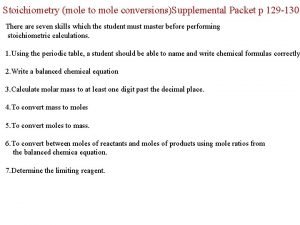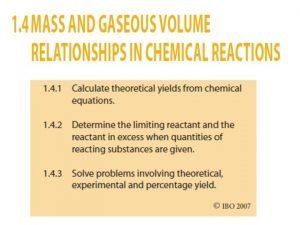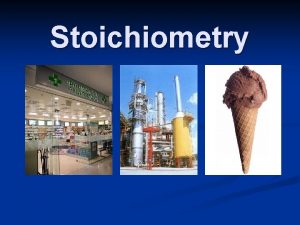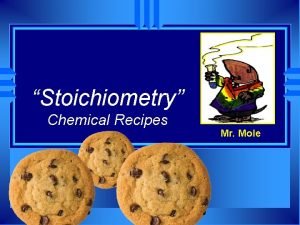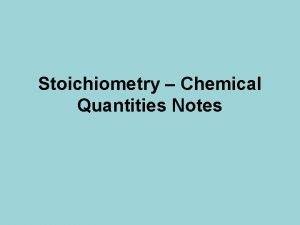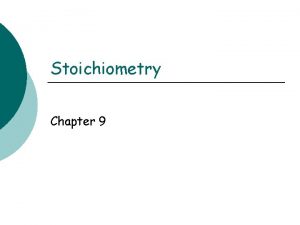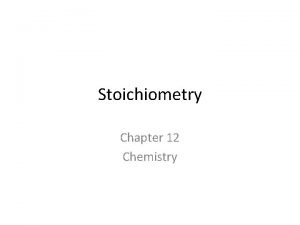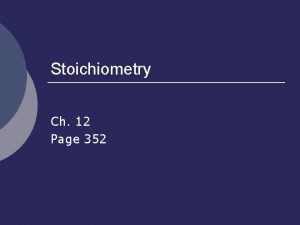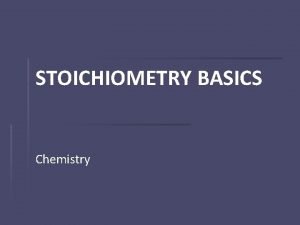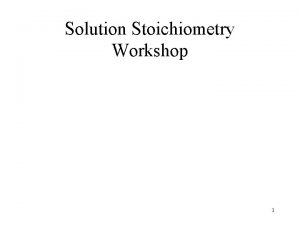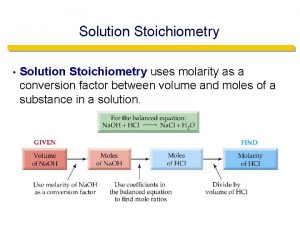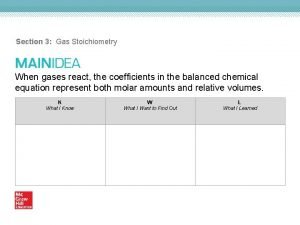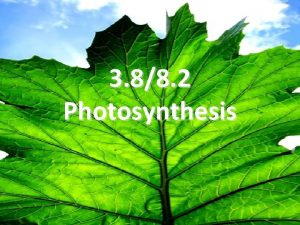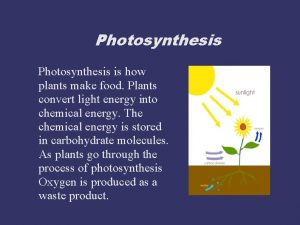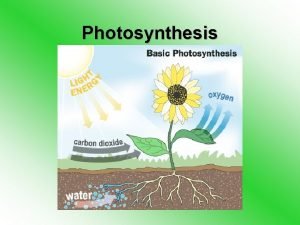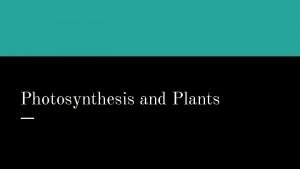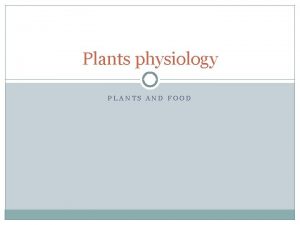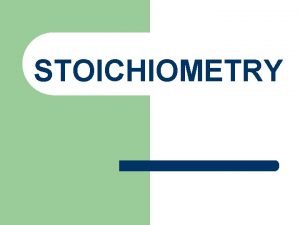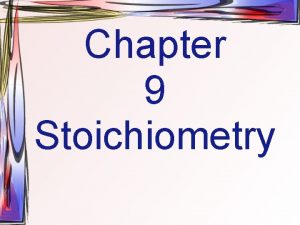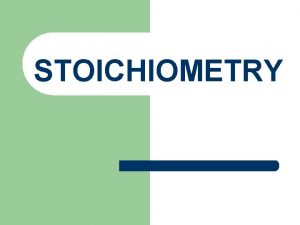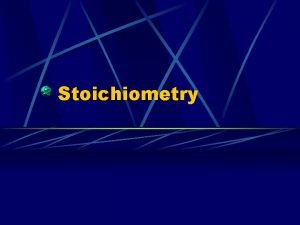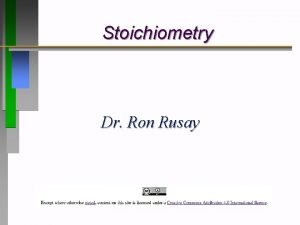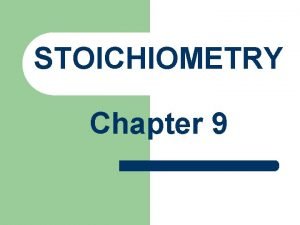Example 4 1 Stoichiometry In photosynthesis plants convert












































- Slides: 44

Example 4. 1 Stoichiometry In photosynthesis, plants convert carbon dioxide and water into glucose (C 6 H 12 O 6) according to the reaction: Suppose you determine that a particular plant consumes 37. 8 g of CO 2 in one week. Assuming that there is more than enough water present to react with all of the CO 2, what mass of glucose (in grams) can the plant synthesize from the CO 2? Sort The problem gives the mass of carbon dioxide and asks you to find the mass of glucose that can be produced. Given: 37. 8 g CO 2 Find: g C 6 H 12 O 6 Strategize The conceptual plan follows the general pattern of mass A → amount A (in moles) → amount B (in moles) → mass B. From the chemical equation, deduce the relationship between moles of carbon dioxide and moles of glucose. Use the molar masses to convert between grams and moles. Conceptual plan Chemistry: A Molecular Approach, 3 rd Edition Nivaldo J. Tro © 2014 Pearson Education, Inc.

Example 4. 1 Stoichiometry Continued Relationships Used molar mass CO 2 = 44. 01 g/mol 6 mol CO 2 : 1 mol C 6 H 12 O 6 molar mass C 6 H 12 O 6 = 180. 2 g/mol Solve Follow the conceptual plan to solve the problem. Begin with g CO 2 and use the conversion factors to arrive at g C 6 H 12 O 6. Solution Check The units of the answer are correct. The magnitude of the answer (25. 8 g) is less than the initial mass of CO 2 (37. 8 g). This is reasonable because each carbon in CO 2 has two oxygen atoms associated with it, while in C 6 H 12 O 6 each carbon has only one oxygen atom associated with it and two hydrogen atoms, which are much lighter than oxygen. Therefore, the mass of glucose produced should be less than the mass of carbon dioxide for this reaction. Chemistry: A Molecular Approach, 3 rd Edition Nivaldo J. Tro © 2014 Pearson Education, Inc.

Example 4. 1 Stoichiometry Continued For Practice 4. 1 Magnesium hydroxide, the active ingredient in milk of magnesia, neutralizes stomach acid, primarily HCl, according to the reaction: What mass of HCl, in grams, is neutralized by a dose of milk of magnesia containing 3. 26 g Mg(OH)2? Chemistry: A Molecular Approach, 3 rd Edition Nivaldo J. Tro © 2014 Pearson Education, Inc.

Example 4. 2 Stoichiometry Sulfuric acid (H 2 SO 4) is a component of acid rain that forms when SO 2, a pollutant, reacts with oxygen and water according to the simplified reaction: The generation of the electricity used by a medium-sized home produces about 25 kg of SO 2 per year. Assuming that there is more than enough O 2 and H 2 O, what mass of H 2 SO 4, in kg, can form from this much SO 2? Sort The problem gives the mass of sulfur dioxide and asks you to find the mass of sulfuric acid. Given: 25 kg SO 2 Find: kg H 2 SO 4 Strategize The conceptual plan follows the standard format of mass → amount (in moles) → mass. Since the original quantity of SO 2 is given in kg, you must first convert to grams. You can deduce the relationship between moles of sulfur dioxide and moles of sulfuric acid from the chemical equation. Since the final quantity is requested in kg, convert to kg at the end. Chemistry: A Molecular Approach, 3 rd Edition Nivaldo J. Tro © 2014 Pearson Education, Inc.

Example 4. 2 Stoichiometry Continued Conceptual Plan Relationships Used 1 kg = 1000 g molar mass SO 2 = 64. 07 g/mol 2 mol SO 2 : 2 mol H 2 SO 4 molar mass H 2 SO 4 = 98. 09 g/mol Solve Follow the conceptual plan to solve the problem. Begin with the given amount of SO 2 in kilograms and use the conversion factors to arrive at kg H 2 SO 4. Chemistry: A Molecular Approach, 3 rd Edition Nivaldo J. Tro © 2014 Pearson Education, Inc.

Example 4. 2 Stoichiometry Continued Solution Check The units of the final answer are correct. The magnitude of the final answer (38 kg H 2 SO 4) is larger than the amount of SO 2 given (25 kg). This is reasonable because in the reaction each SO 2 molecule “gains weight” by reacting with O 2 and H 2 O. For Practice 4. 2 Another component of acid rain is nitric acid, which forms when NO 2, also a pollutant, reacts with oxygen and water according to the simplified equation: The generation of the electricity used by a medium-sized home produces about 16 kg of NO 2 per year. Assuming that there is adequate O 2 and H 2 O, what mass of HNO 3, in kg, can form from this amount of NO 2 pollutant? Chemistry: A Molecular Approach, 3 rd Edition Nivaldo J. Tro © 2014 Pearson Education, Inc.

Example 4. 3 Limiting Reactant and Theoretical Yield Ammonia, NH 3, can be synthesized by the reaction: Starting with 86. 3 g NO and 25. 6 g H 2, find theoretical yield of ammonia in grams. Sort You are given the mass of each reactant in grams and asked to find theoretical yield of a product. Given: 86. 3 g NO, 25. 6 g H 2 Find: theoretical yield of NH 3(g) Strategize Determine which reactant makes the least amount of product by converting from grams of each reactant to moles of the product. Use molar masses to convert between grams and moles and use the stoichiometric relationships (deduced from the chemical equation) to convert between moles of reactant and moles of product. Remember that the reactant that makes the least amount of product is the limiting reactant. Convert the number of moles of product obtained using the limiting reactant to grams of product. Chemistry: A Molecular Approach, 3 rd Edition Nivaldo J. Tro © 2014 Pearson Education, Inc.

Example 4. 3 Limiting Reactant and Theoretical Yield Continued Conceptual plan Relationships Used molar mass NO = 30. 01 g/mol molar mass H 2 = 2. 02 g/mol 2 mol NO : 2 mol NH 3 (from chemical equation) 5 mol H 2 : 2 mol NH 3 (from chemical equation) molar mass NH 3 = 17. 03 g/mol Solve Beginning with the given mass of each reactant, calculate the amount of product that can be made in moles. Convert the amount of product made by the limiting reactant to grams—this is theoretical yield. Chemistry: A Molecular Approach, 3 rd Edition Nivaldo J. Tro © 2014 Pearson Education, Inc.

Example 4. 3 Limiting Reactant and Theoretical Yield Continued Solution Since NO makes the least amount of product, it is the limiting reactant, and theoretical yield of ammonia is 49. 0 g. Check The units of the answer (g NH 3) are correct. The magnitude (49. 0 g) seems reasonable given that 86. 3 g NO is the limiting reactant. NO contains one oxygen atom per nitrogen atom and NH 3 contains three hydrogen atoms per nitrogen atom. Since three hydrogen atoms have less mass than one oxygen atom, it is reasonable that the mass of NH 3 obtained is less than the mass of NO. For Practice 4. 3 Ammonia can also be synthesized by the reaction: What is theoretical yield of ammonia, in kg, that we can synthesize from 5. 22 kg of H 2 and 31. 5 kg of N 2? Chemistry: A Molecular Approach, 3 rd Edition Nivaldo J. Tro © 2014 Pearson Education, Inc.

Example 4. 4 Limiting Reactant and Theoretical Yield We can obtain titanium metal from its oxide according to the following balanced equation: When 28. 6 kg of C reacts with 88. 2 kg of Ti. O 2, 42. 8 kg of Ti is produced. Find the limiting reactant, theoretical yield (in kg), and percent yield. Sort You are given the mass of each reactant and the mass of product formed. You are asked to find the limiting reactant, theoretical yield, and percent yield. Given: 28. 6 kg C, 88. 2 kg Ti. O 2, 42. 8 kg Ti produced Find: limiting reactant, theoretical yield, % yield Strategize Determine which of the reactants makes the least amount of product by converting from kilograms of each reactant to moles of product. Convert between grams and moles using molar mass. Convert between moles of reactant and moles of product using the stoichiometric relationships derived from the chemical equation. Remember that the reactant that makes the least amount of product is the limiting reactant. Determine theoretical yield (in kg) by converting the number of moles of product obtained with the limiting reactant to kilograms of product. Chemistry: A Molecular Approach, 3 rd Edition Nivaldo J. Tro © 2014 Pearson Education, Inc.

Example 4. 4 Limiting Reactant and Theoretical Yield Continued Conceptual Plan Relationships Used 1000 g = 1 kg molar mass of C = 12. 01 g/ molar mass of Ti. O 2 = 79. 87 g/ mol 1 mol Ti. O 2 : 1 mol Ti 2 mol C : 1 mol Ti molar mass of Ti = 47. 87 g/mol Solve Beginning with the actual amount of each reactant, calculate the amount of product that can be made in moles. Convert the amount of product made by the limiting reactant to kilograms—this is theoretical yield. Calculate the percent yield by dividing the actual yield (42. 8 kg Ti) by theoretical yield. Chemistry: A Molecular Approach, 3 rd Edition Nivaldo J. Tro © 2014 Pearson Education, Inc.

Example 4. 4 Limiting Reactant and Theoretical Yield Continued Solution Since Ti. O 2 makes the least amount of product, it is the limiting reactant, and 52. 9 kg Ti is theoretical yield. Chemistry: A Molecular Approach, 3 rd Edition Nivaldo J. Tro © 2014 Pearson Education, Inc.

Example 4. 4 Limiting Reactant and Theoretical Yield Continued Check The theoretical yield has the correct units (kg Ti) and has a reasonable magnitude compared to the mass of Ti. O 2. Since Ti has a lower molar mass than Ti. O 2, the amount of Ti made from Ti. O 2 should have a lower mass. The percent yield is reasonable (under 100% as it should be). For Practice 4. 4 Mining companies use this reaction to obtain iron from iron ore: The reaction of 167 g Fe 2 O 3 with 85. 8 g CO produces 72. 3 g Fe. Determine the limiting reactant, theoretical yield, and percent yield. Chemistry: A Molecular Approach, 3 rd Edition Nivaldo J. Tro © 2014 Pearson Education, Inc.

Example 4. 5 Calculating Solution Concentration If you dissolve 25. 5 g KBr in enough water to make 1. 75 L of solution, what is the molarity of the solution? Sort You are given the mass of KBr and the volume of a solution and asked to find its molarity. Given: 25. 5 g KBr, 1. 75 L of solution Find: molarity (M) Strategıze When formulating the conceptual plan, think about the definition of molarity, the amount of solute in moles per liter of solution. You are given the mass of KBr, so first use the molar mass of KBr to convert from g KBr to mol KBr. Then use the number of moles of KBr and liters of solution to find the molarity. Conceptual Plan Chemistry: A Molecular Approach, 3 rd Edition Nivaldo J. Tro © 2014 Pearson Education, Inc.

Example 4. 5 Calculating Solution Concentration Continued Relationships Used molar mass of KBr = 119. 00 g/mol Solve Follow the conceptual plan. Begin with g KBr and convert to mol KBr; then use mol KBr and L solution to calculate molarity. Solution Check The units of the answer (M) are correct. The magnitude is reasonable since common solutions range in concentration from 0 to about 18 M. Concentrations significantly above 18 M are suspect and should be double-checked. Chemistry: A Molecular Approach, 3 rd Edition Nivaldo J. Tro © 2014 Pearson Education, Inc.

Example 4. 5 Calculating Solution Concentration Continued For Practice 4. 5 Calculate the molarity of a solution made by adding 45. 4 g of Na. NO 3 to a flask and dissolving it with water to create a total volume of 2. 50 L. For More Practice 4. 5 What mass of KBr (in grams) do you need to make 250. 0 m. L of a 1. 50 M KBr solution? Chemistry: A Molecular Approach, 3 rd Edition Nivaldo J. Tro © 2014 Pearson Education, Inc.

Example 4. 6 Using Molarity in Calculations How many liters of a 0. 125 M Na. OH solution contain 0. 255 mol of Na. OH? Sort You are given the concentration of a Na. OH solution. You are asked to find the volume of the solution that contains a given amount (in moles) of Na. OH. Given: 0. 125 M Na. OH solution, 0. 255 mol Na. OH Find: volume of Na. OH solution (in L) Strategıze The conceptual plan begins with mol Na. OH and shows the conversion to L of solution using molarity as a conversion factor. Conceptual Plan Relationships Used Chemistry: A Molecular Approach, 3 rd Edition Nivaldo J. Tro © 2014 Pearson Education, Inc.

Example 4. 6 Using Molarity in Calculations Continued Solve Follow the conceptual plan. Begin with mol Na. OH and convert to L solution. Solution Check The units of the answer (L) are correct. The magnitude is reasonable because the solution contains 0. 125 mol per liter. Therefore, roughly 2 L contains the given amount of moles (0. 255 mol). For Practice 4. 6 How many grams of sucrose (C 12 H 22 O 11) are in 1. 55 L of 0. 758 M sucrose solution? For More Practice 4. 6 How many m. L of a 0. 155 M KCl solution contain 2. 55 g KCl? Chemistry: A Molecular Approach, 3 rd Edition Nivaldo J. Tro © 2014 Pearson Education, Inc.

Example 4. 7 Solution Dilution To what volume should you dilute 0. 200 L of a 15. 0 M Na. OH solution to obtain a 3. 00 M Na. OH solution? Sort You are given the initial volume, initial concentration, and final concentration of a solution, and you need to determine the final volume. Given: Find: V 2 V 1 = 0. 200 L M 1 = 15. 0 M M 2 = 3. 00 M Strategıze Equation 4. 1 relates the initial and final volumes and concentrations for solution dilution problems. You are asked to find V 2. The other quantities (V 1, M 1, and M 2) are all given in the problem. Conceptual Plan Relationships Used M 1 V 1 = M 2 V 2 Chemistry: A Molecular Approach, 3 rd Edition Nivaldo J. Tro © 2014 Pearson Education, Inc.

Example 4. 7 Solution Dilution Continued Solve Begin with the solution dilution equation and solve it for V 2. Substitute in the required quantities and calculate V 2. Make the solution by diluting 0. 200 L of the stock solution to a total volume of 1. 00 L (V 2). The resulting solution will have a concentration of 3. 00 M. Solution Check The final units (L) are correct. The magnitude of the answer is reasonable because the solution is diluted from 15. 0 M to 3. 00 M, a factor of five. Therefore the volume should increase by a factor of five. For Practice 4. 7 To what volume (in m. L) should you dilute 100. 0 m. L of a 5. 00 M Ca. C 2 solution to obtain a 0. 750 M Ca. C 2 solution? For More Practice 4. 7 What volume of a 6. 00 M Na. NO 3 solution should you use to make 0. 525 L of a 1. 20 M Na. NO 3 solution? Chemistry: A Molecular Approach, 3 rd Edition Nivaldo J. Tro © 2014 Pearson Education, Inc.

Example 4. 8 Solution Stoichiometry What volume (in L) of 0. 150 M KCl solution will completely react with 0. 150 L of a 0. 175 M Pb(NO 3)2 solution according to the following balanced chemical equation? Sort You are given the volume and concentration of a Pb(NO 3)2 solution. You are asked to find the volume of KCl solution (of a given concentration) required to react with it. Given: 0. 150 L of Pb(NO 3)2 solution, 0. 175 M Pb(NO 3)2 solution, 0. 150 M KCl solution Find: volume KCl solution (in L) Strategize The conceptual plan has the form: volume A → amount A (in moles) → amount B (in moles) → volume B. Use the molar concentrations of the KCl and Pb(NO 3)2 solutions as conversion factors between the number of moles of reactants in these solutions and their volumes. Use the stoichiometric coefficients from the balanced equation to convert between number of moles of Pb(NO 3)2 and number of moles of KCl. Chemistry: A Molecular Approach, 3 rd Edition Nivaldo J. Tro © 2014 Pearson Education, Inc.

Example 4. 8 Solution Stoichiometry Continued Conceptual Plan Relationships Used Chemistry: A Molecular Approach, 3 rd Edition Nivaldo J. Tro © 2014 Pearson Education, Inc.

Example 4. 8 Solution Stoichiometry Continued Solve Begin with L Pb(NO 3)2 solution and follow the conceptual plan to arrive at L KCl solution. Solution Check The final units (L KCl solution) are correct. The magnitude (0. 350 L) is reasonable because the reaction stoichiometry requires 2 mol of KCl per mole of Pb(NO 3)2. Since the concentrations of the two solutions are not very different (0. 150 M compared to 0. 175 M), the volume of KCl required is roughly two times the 0. 150 L of Pb(NO 3)2 given in the problem. For Practice 4. 8 What volume (in m. L) of a 0. 150 M HNO 3 solution will completely react with 35. 7 m. L of a 0. 108 M Na 2 CO 3 solution according to the following balanced chemical equation? For More Practice 4. 8 In the previous reaction, what mass (in grams) of carbon dioxide forms? Chemistry: A Molecular Approach, 3 rd Edition Nivaldo J. Tro © 2014 Pearson Education, Inc.

Example 4. 9 Predicting whether an Ionic Compound Is Soluble Predict whether each compound is soluble or insoluble. a. Pb. Cl 2 b. Cu. Cl 2 c. Ca(NO 3)2 d. Ba. SO 4 Solution a. Insoluble. Compounds containing Cl− are normally soluble, but Pb 2+ is an exception. b. Soluble. Compounds containing Cl− are normally soluble and Cu 2+ is not an exception. c. Soluble. Compounds containing NO 3− are always soluble. d. Insoluble. Compounds containing SO 42− are normally soluble, but Ba 2+ is an exception. Strategize Predict whether each compound is soluble or insoluble. a. Ni. S b. Mg 3(PO 4)2 c. Li 2 CO 3 d. NH 4 Cl Chemistry: A Molecular Approach, 3 rd Edition Nivaldo J. Tro © 2014 Pearson Education, Inc.

Example 4. 10 Writing Equations for Precipitation Reactions Write an equation for the precipitation reaction that occurs (if any) when solutions of potassium carbonate and nickel(II) chloride are mixed. Procedure For… Writing Equations for Precipitation Reactions Step 1 Write the formulas of the two compounds being mixed as reactants in a chemical equation. Step 2 Below the equation, write the formulas of the products that could form from the reactants. Obtain these by combining the cation from each reactant with the anion from the other. Make sure to write correct formulas for these ionic compounds using the procedure demonstrated in Section 3. 5. Step 3 Refer to the solubility rules to determine whether any of the possible products are insoluble. KCl is soluble. (Compounds containing Cl− are usually soluble and K+ is not an exception. ) Ni. CO 3 is insoluble. (Compounds containing CO 32− are usually insoluble and Ni 2+ is not an exception. ) Chemistry: A Molecular Approach, 3 rd Edition Nivaldo J. Tro © 2014 Pearson Education, Inc.

Example 4. 10 Writing Equations for Precipitation Reactions Continued Step 4 If all of the possible products are soluble, there will be no precipitate. Write “NO REACTION” after the arrow. Since this example has an insoluble product, we proceed to the next step. Step 5 If any of the possible products are insoluble, write their formulas as the products of the reaction, using (s) to indicate solid. Write any soluble products with (aq) to indicate aqueous. Step 6 Balance the equation. Remember to adjust only coefficients, not subscripts. For Practice 4. 10 Write an equation for the precipitation reaction that occurs (if any) when solutions of ammonium chloride and iron(III) nitrate are mixed. Chemistry: A Molecular Approach, 3 rd Edition Nivaldo J. Tro © 2014 Pearson Education, Inc.

Example 4. 11 Writing Equations for Precipitation Reactions Write an equation for the precipitation reaction that occurs (if any) when solutions of sodium nitrate and lithium sulfate are mixed. Procedure For… Writing Equations for Precipitation Reactions Step 1 Write the formulas of the two compounds being mixed as reactants in a chemical equation. Step 2 Below the equation, write the formulas of the products that could form from the reactants. Obtain these by combining the cation from each reactant with the anion from the other. Make sure to write correct formulas for these ionic compounds using the procedure demonstrated in Section 3. 5. Step 3 Refer to the solubility rules to determine whether any of the possible products are insoluble. Li. NO 3 is soluble. (Compounds containing NO 3− are soluble and Li+ is not an exception. ) Na 2 SO 4 is soluble. (Compounds containing SO 42− are generally soluble and Na+ is not an exception. ) Chemistry: A Molecular Approach, 3 rd Edition Nivaldo J. Tro © 2014 Pearson Education, Inc.

Example 4. 11 Writing Equations for Precipitation Reactions Continued Step 4 If all of the possible products are soluble, there will be no precipitate. Write “NO REACTION” after the arrow. Since this example has no insoluble product, there is no reaction. Step 5 If any of the possible products are insoluble, write their formulas as the products of the reaction, using (s) to indicate solid. Write any soluble products with (aq) to indicate aqueous. Step 6 Balance the equation. Remember to adjust only coefficients, not subscripts. For Practice 4. 11 Write an equation for the precipitation reaction that occurs (if any) when solutions of sodium hydroxide and copper(II) bromide are mixed. Chemistry: A Molecular Approach, 3 rd Edition Nivaldo J. Tro © 2014 Pearson Education, Inc.

Example 4. 12 Writing Complete Ionic and Net Ionic Equations Write complete ionic and net ionic equations for each reaction. a. b. Solution a. Write the complete ionic equation by separating aqueous ionic compounds into their constituent ions. The Sr 3(PO 4)2(s), precipitating as a solid, remains as one unit. Write the net ionic equation by eliminating the spectator ions, those that do not change from one side of the reaction to the other. Complete ionic equation: Net ionic equation: Chemistry: A Molecular Approach, 3 rd Edition Nivaldo J. Tro © 2014 Pearson Education, Inc.

Example 4. 12 Writing Complete Ionic and Net Ionic Equations Continued b. Write the complete ionic equation by separating aqueous ionic compounds into their constituent ions. Do not separate HC 2 H 3 O 2(aq) because it is a weak electrolyte. Write the net ionic equation by eliminating the spectator ions. Complete ionic equation: Net ionic equation: For Practice 4. 12 Consider the following reaction occurring in aqueous solution: Write the complete ionic equation and net ionic equation for this reaction. Chemistry: A Molecular Approach, 3 rd Edition Nivaldo J. Tro © 2014 Pearson Education, Inc.

Example 4. 13 Writing Equations for Acid–Base Reactions Write a molecular and net ionic equation for the reaction between aqueous HI and aqueous Ba(OH) 2. Solution First identify these substances as an acid and a base. Begin by writing the unbalanced equation in which the acid and the base combine to form water and a salt. Next, balance the equation; this is the molecular equation. Write the net ionic equation by removing the spectator ions. For Practice 4. 13 Write a molecular and a net ionic equation for the reaction that occurs between aqueous H 2 SO 4 and aqueous Li. OH. Chemistry: A Molecular Approach, 3 rd Edition Nivaldo J. Tro © 2014 Pearson Education, Inc.

Example 4. 14 Acid–Base Titration The titration of a 10. 00 m. L sample of an HCl solution of unknown concentration requires 12. 54 m. L of a 0. 100 M Na. OH solution to reach the equivalence point. What is the concentration of the unknown HCl solution in M? Sort You are given the volume and concentration of Na. OH solution required to titrate a given volume of HCl solution. You are asked to find the concentration of the HCl solution. Given: 12. 54 m. L of Na. OH solution, 0. 100 M Na. OH solution, 10. 00 m. L of HCl solution Find: concentration of HCl solution Strategıze Since this problem involves an acid–base neutralization reaction between HCl and Na. OH, you start by writing the balanced equation, using the techniques covered earlier in this section. The first part of the conceptual plan has the form volume A → moles B. The concentration of the Na. OH solution is a conversion factor between moles and volume of Na. OH. The balanced equation provides the relationship between number of moles of Na. OH and number of moles of HCl. In the second part of the conceptual plan, use the number of moles of HCl (from the first part) and the volume of HCl solution (given) to calculate the molarity of the HCl solution. Chemistry: A Molecular Approach, 3 rd Edition Nivaldo J. Tro © 2014 Pearson Education, Inc.

Example 4. 14 Acid–Base Titration Continued Conceptual Plan Relationships Used Chemistry: A Molecular Approach, 3 rd Edition Nivaldo J. Tro © 2014 Pearson Education, Inc.

Example 4. 14 Acid–Base Titration Continued Solve In the first part of the solution, determine the number of moles of HCl in the unknown solution. In the second part of the solution, divide the number of moles of HCl by the volume of the HCl solution in L. 10. 00 m. L is equivalent to 0. 01000 L. Solution Check The units of the answer (M HCl) are correct. The magnitude of the answer (0. 125 M) is reasonable because it is similar to the molarity of the Na. OH solution, as expected from the reaction stoichiometry (1 mol HCl reacts with 1 mol Na. OH) and the similar volumes of Na. OH and HCl. Chemistry: A Molecular Approach, 3 rd Edition Nivaldo J. Tro © 2014 Pearson Education, Inc.

Example 4. 14 Acid–Base Titration Continued For Practice 4. 14 The titration of a 20. 0 m. L sample of an H 2 SO 4 solution of unknown concentration requires 22. 87 m. L of a 0. 158 M KOH solution to reach the equivalence point. What is the concentration of the unknown H 2 SO 4 solution? For More Practice 4. 14 What volume (in m. L) of 0. 200 M Na. OH do we need to titrate 35. 00 m. L of 0. 140 M HBr to the equivalence point? Chemistry: A Molecular Approach, 3 rd Edition Nivaldo J. Tro © 2014 Pearson Education, Inc.

Example 4. 15 Writing Equations for Gas-Evolution Reactions Write a molecular equation for the gas-evolution reaction that occurs when you mix aqueous nitric acid and aqueous sodium carbonate. Begin by writing an unbalanced equation in which the cation of each reactant combines with the anion of the other. You must then recognize that H 2 CO 3(aq) decomposes into H 2 O(l) and CO 2(g) and write these products into the equation. Finally, balance the equation. For Practice 4. 15 Write a molecular equation for the gas-evolution reaction that occurs when you mix aqueous hydrobromic acid and aqueous potassium sulfite. For More Practice 4. 15 Write a net ionic equation for the reaction that occurs when you mix hydroiodic acid with calcium sulfide. Chemistry: A Molecular Approach, 3 rd Edition Nivaldo J. Tro © 2014 Pearson Education, Inc.

Example 4. 16 Assigning Oxidation States Assign an oxidation state to each atom in each element, ion, or compound. a. Cl 2 b. Na+ c. KF d. CO 2 e. SO 42− f. K 2 O 2 Solution a. Since Cl 2 is a free element, the oxidation state of both Cl atoms is 0 (rule 1). b. Since Na+ is a monoatomic ion, the oxidation state of the Na+ ion is +1 (rule 2). c. The oxidation state of K is +1 (rule 4). The oxidation state of F is − 1 (rule 5). Since this is a neutral compound, the sum of the oxidation states is 0. Chemistry: A Molecular Approach, 3 rd Edition Nivaldo J. Tro © 2014 Pearson Education, Inc.

Example 4. 16 Assigning Oxidation States Continued d. The oxidation state of oxygen is − 2 (rule 5). The oxidation state of carbon must be deduced using rule 3, which says that the sum of the oxidation states of all the atoms must be 0. e. The oxidation state of oxygen is − 2 (rule 5). We would ordinarily expect the oxidation state of S to be − 2 (rule 5). However, if that were the case, the sum of the oxidation states would not equal the charge of the ion. Since O is higher on the list than S, it takes priority and we compute the oxidation state of sulfur by setting the sum of all of the oxidation states equal to − 2 (the charge of the ion). Chemistry: A Molecular Approach, 3 rd Edition Nivaldo J. Tro © 2014 Pearson Education, Inc.

Example 4. 16 Assigning Oxidation States Continued f. The oxidation state of potassium is +1 (rule 4). We would ordinarily expect the oxidation state of O to be − 2 (rule 5), but rule 4 takes priority, and we deduce the oxidation state of O by setting the sum of all of the oxidation states equal to 0. For Practice 4. 16 Assign an oxidation state to each atom in each element, ion, or compound. a. Cr b. Cr 3+ c. CCl 4 d. Sr. Br 2 e. SO 3 f. NO 3− Chemistry: A Molecular Approach, 3 rd Edition Nivaldo J. Tro © 2014 Pearson Education, Inc.

Example 4. 17 Using Oxidation States to Identify Oxidation and Reduction Use oxidation states to identify the element that is oxidized and the element that is reduced in the following redox reaction. Solution Begin by assigning oxidation states to each atom in the reaction. Since Mg increased in oxidation state, it was oxidized. Since H decreased in oxidation state, it was reduced. For Practice 4. 17 Use oxidation states to identify the element that is oxidized and the element that is reduced in the following redox reaction. Chemistry: A Molecular Approach, 3 rd Edition Nivaldo J. Tro © 2014 Pearson Education, Inc.

Example 4. 17 Using Oxidation States to Identify Oxidation and Reduction Continued For More Practice 4. 17 Determine whether or not each reaction is a redox reaction. If the reaction is a redox reaction, identify which element is oxidized and which is reduced. Chemistry: A Molecular Approach, 3 rd Edition Nivaldo J. Tro © 2014 Pearson Education, Inc.

Example 4. 18 Identifying Redox Reactions, Oxidizing Agents, and Reducing Agents Determine whether each reaction is an oxidation–reduction reaction. For each oxidation–reduction reaction, identify the oxidizing agent and the reducing agent. a. b. c. Solution a. This is a redox reaction because magnesium increases in oxidation number (oxidation) and oxygen decreases in oxidation number (reduction). b. This is not a redox reaction because none of the atoms undergo a change in oxidation number. Chemistry: A Molecular Approach, 3 rd Edition Nivaldo J. Tro © 2014 Pearson Education, Inc.

Example 4. 18 Identifying Redox Reactions, Oxidizing Agents, and Reducing Agents Continued c. This is not a redox reaction because none of the atoms undergo a change in oxidation number. For Practice 4. 18 Determine whether or not each reaction is a redox reaction. For all redox reactions, identify the oxidizing agent and the reducing agent. a. b. c. d. Chemistry: A Molecular Approach, 3 rd Edition Nivaldo J. Tro © 2014 Pearson Education, Inc.

Example 4. 19 Writing Equations for Combustion Reactions Assign an oxidation state to each atom in each element, ion, or compound. Solution Begin by writing an unbalanced equation showing the reaction of CH 3 OH with O 2 to form CO 2 and H 2 O. Balance the equation using the guidelines in Section 3. 10. For Practice 4. 19 Write a balanced equation for the complete combustion of liquid C 2 H 5 SH. Chemistry: A Molecular Approach, 3 rd Edition Nivaldo J. Tro © 2014 Pearson Education, Inc.
 Photosynthesis stoichiometry
Photosynthesis stoichiometry The food that plants produce during photosynthesis is
The food that plants produce during photosynthesis is What is the word equation of photosynthesis
What is the word equation of photosynthesis Define photosynthesis
Define photosynthesis Green plants make their own food by photosynthesis
Green plants make their own food by photosynthesis How does moss reproduce
How does moss reproduce Nonvascular plant diagram
Nonvascular plant diagram Classify non flowering plants
Classify non flowering plants C3 plants vs c4 plants
C3 plants vs c4 plants Mass to mass formula
Mass to mass formula Stoichiometry examples
Stoichiometry examples Stoichiometry definition
Stoichiometry definition Internal leaf diagram
Internal leaf diagram Example of biennial plants
Example of biennial plants Gravimetric stoichiometry
Gravimetric stoichiometry Stoichiometry mole island diagram
Stoichiometry mole island diagram Stoichiometry: mole-mole problems
Stoichiometry: mole-mole problems Chemical rxns/balancing equ./stoichiometry
Chemical rxns/balancing equ./stoichiometry How to calculate molarity
How to calculate molarity Titration stoichiometry
Titration stoichiometry Stoichiometry game
Stoichiometry game The mole roadmap
The mole roadmap Gas stoichiometry worksheet
Gas stoichiometry worksheet Stoichiometry refers to
Stoichiometry refers to Stoichiometry deals with
Stoichiometry deals with Stoichiometry is defined as the quantitative study of
Stoichiometry is defined as the quantitative study of Stoichiometry deals with
Stoichiometry deals with What stoichiometry
What stoichiometry Stoichiometry island diagram
Stoichiometry island diagram Stoichiometry
Stoichiometry Stoichiometry is a quantitative study because
Stoichiometry is a quantitative study because Introduction to stoichiometry
Introduction to stoichiometry Stoicheion meaning
Stoicheion meaning Define reaction stoichiometry
Define reaction stoichiometry Stoichiometry in greek
Stoichiometry in greek Mole cookies chemistry
Mole cookies chemistry Stoichiometry equation
Stoichiometry equation Chemistry chapter 9 stoichiometry
Chemistry chapter 9 stoichiometry Cookie stoichiometry
Cookie stoichiometry Cookie stoichiometry
Cookie stoichiometry What is stoichiometry
What is stoichiometry Stoichiometry basics
Stoichiometry basics Molarity and stoichiometry
Molarity and stoichiometry Molarity stoichiometry
Molarity stoichiometry Stoichiometry of gases
Stoichiometry of gases
